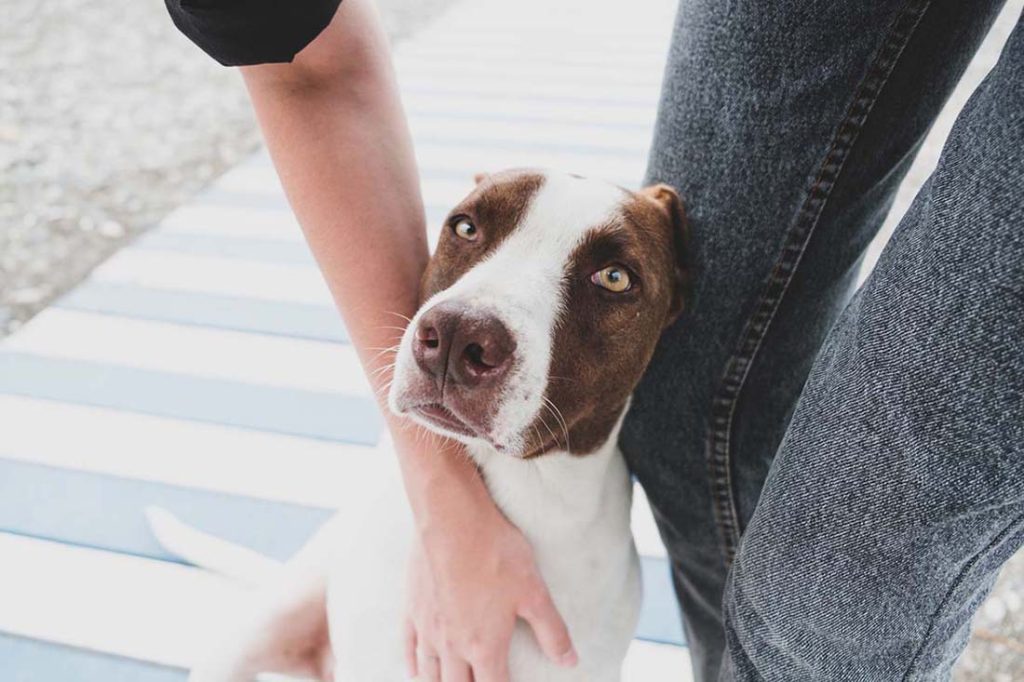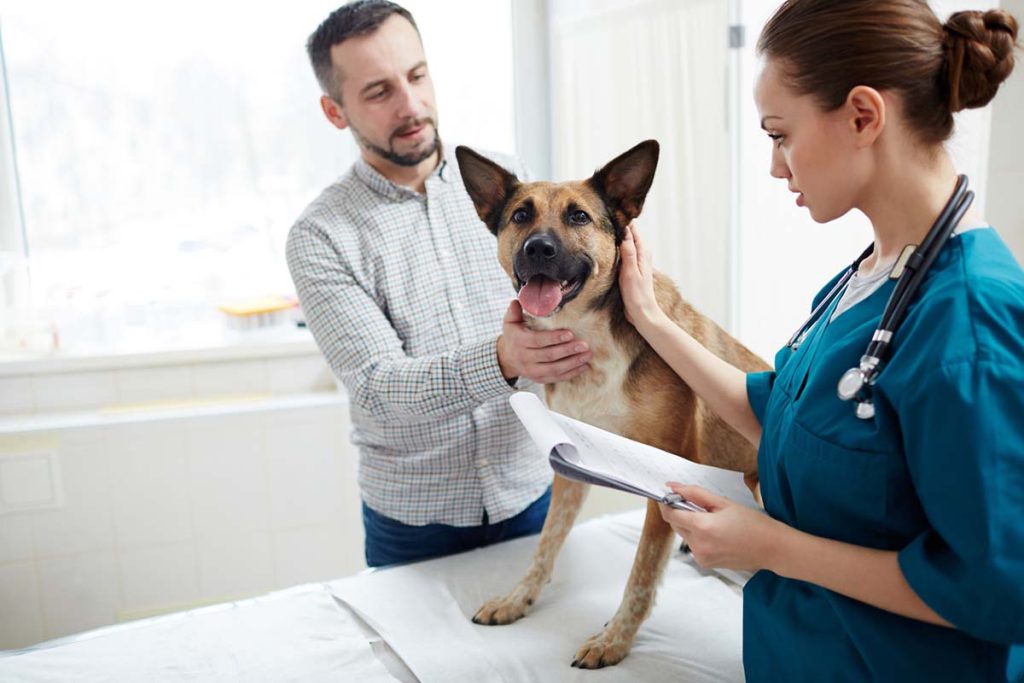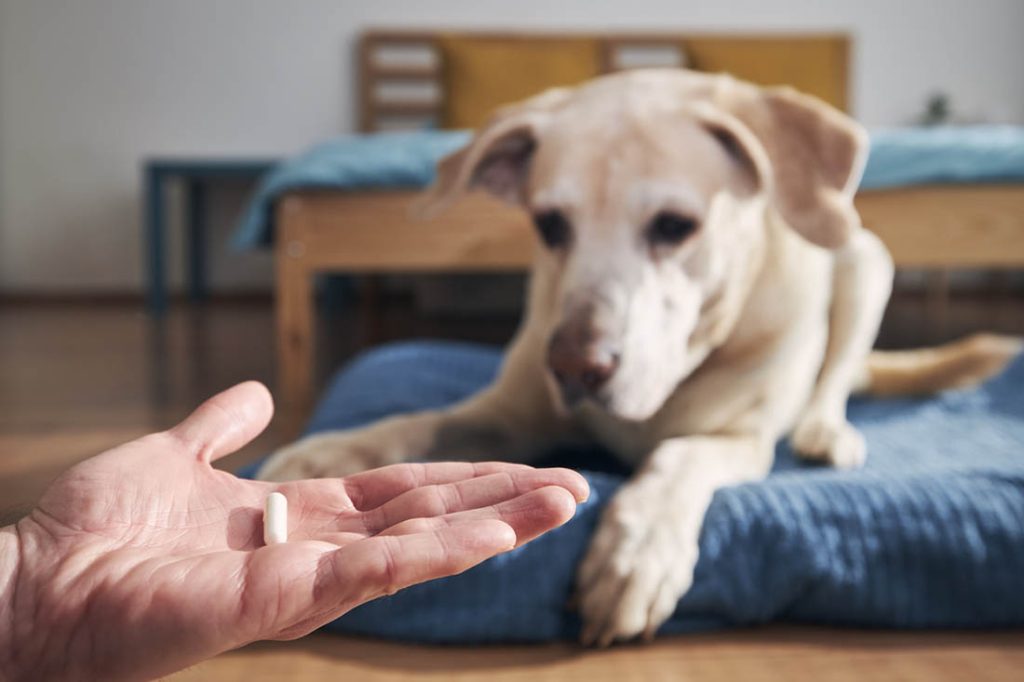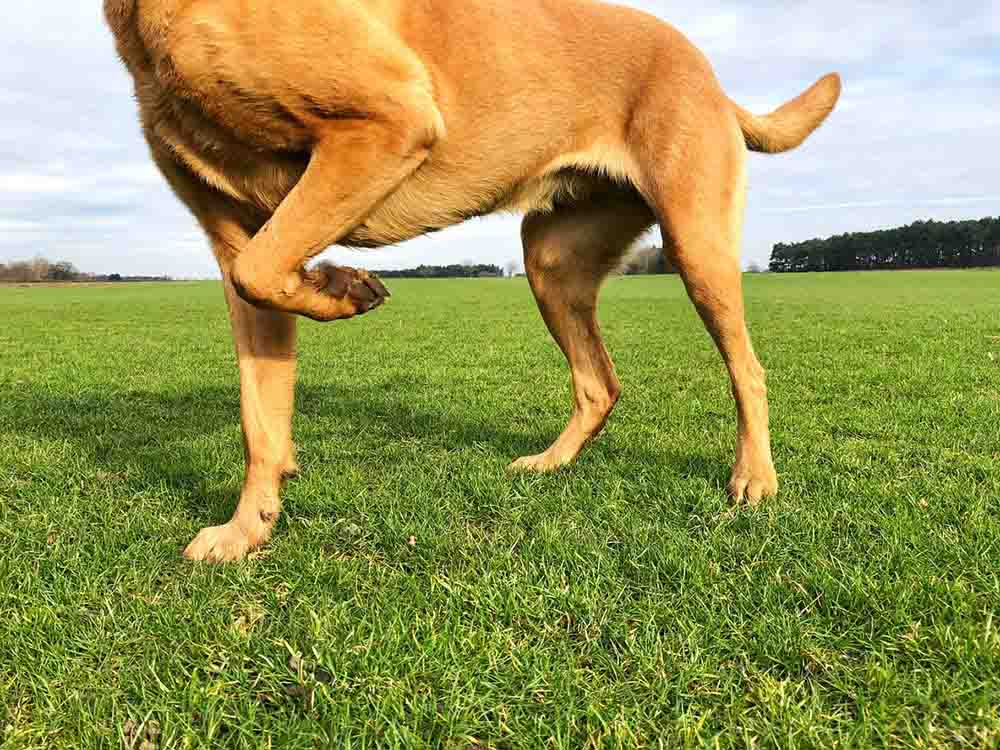Loving pet parents are extremely distressed when they recognize their pet is in pain. Pain management in our best friends can be an important part of ensuring that your dog’s quality of life is maintained throughout his life.
But how do you tell if your dog is in pain? What are the common signs and causes of pain in your dog, and what can you do about it? Let’s take a look at the warning signs you should be aware of and how you can help to maintain your dog’s well-being.
Skip to:
Why Is Recognizing the Signs of Pain in Your Dog So Important?
Being able to recognize the signs of pain in your furry friend is vital for catching problems early before they begin to affect your dog’s well-being. Moreover, research shows that owners can reliably spot certain behavioral changes indicating their pooch is in pain.
Spotting certain subtle changes can help your veterinarian determine the cause and treat it so that your dog’s quality of life remains high. Subtle changes include:
- differences in sleeping habits
- excessive licking
- loss of appetite
- changes in social interaction and behavior
No one knows their dog better than that pooch’s pet parent. Dogs, like humans, vary in their reactions to pain. Some are very stoic, while others whimper at the first sign of even a mild pain stimulus.
Research even indicates that veterinarians and pet owners alike are biased about which breeds are more sensitive to pain, with small breeds perceived to have a lower tolerance. This is important because it can affect how we humans react to the pain our four-legged friends may be experiencing.
If we think they are overreacting, we may be slower to get them the relief they might need. We might also inadvertently allow a problem to progress to the point where pain medication and other treatments might not be able to help.
That’s why it’s vital to understand the signs of pain in dogs and what we can do to help. Let’s take a look at how you can tell if your dog is in pain.
How Can You Tell If Your Dog Is in Pain?

Your dog might be the type who could win an Oscar for his dramatic responses to even the threat of pain, but how can you know for sure? While you might expect them to solicit help when they feel pain, that’s not usually what happens.
In fact, research shows that many dogs will hide when in pain rather than seek out their owner. It makes sense because, in the wild, an animal showing pain is more vulnerable to predation or aggression from other animals. Your dog may not be wild, but he did inherit that instinct from his wild ancestors.
That means pet parents need to look for subtle signs and know their dog’s normal baseline behavior and activity levels. The first sign of pain may not be something obvious but rather minor differences in their behaviors or physical activities.
In other words, you have to be alert to anything that’s not normal for your pooch.
Physical Signs

Let’s begin with the physical signs of pain in dogs. These are often easier to notice and associate with pain. While they may be obvious, such as with limping, they can also be subtle, such as simply not being able to go as far on a daily walk.
Here’s a closer look at what you might see in your dog’s physical behavior and presentation.
7 Physical Signs of Pain in Dogs
- Mobility Issues: Your dog might limp when experiencing pain, but even if he doesn’t, he might simply walk more slowly. He might also be reluctant to go up or down stairs he normally navigates with ease. He might hesitate to jump up on furniture.
- Positional Difficulties: Your dog might also have problems shifting positions. For example, he might have issues getting up or lying down. He might do that more slowly than he normally does or shift his position more frequently as he tries to get comfortable. You might also hear him grunting while he does this.
- Shaking or Trembling: You might also notice your dog shaking or trembling while he attempts to do something or even when he’s sitting still.
- Strikes a Strange Pose: Another common sign of pain in dogs is an abnormal posture. A hunched back might indicate pain in the vertebral column, for example. Shifting his weight forward or backward might be a sign he’s trying to take pressure off of painful joints.
- Excessive Licking or Panting: When you think about how you react to pain, you often experience an increase in your breathing or heart rate. That’s also common for your dog. While you can’t see his heart rate, you can see if he is licking or panting excessively.
- Changes in Facial Expression: Your dog’s face might seem strained. He might even appear to have a grimace or a blank expression when he’s usually more animated. You might also see him drifting off to sleep with his eyes half closed since the pain could be interfering with his ability to sleep.
- Loss of Appetite: Not eating is a common indicator of pain in dogs.
Behavioral Signs of Pain

Just like how you can get cranky when you’re in pain, you might also see changes in your dog’s behavior when he’s in pain. You’ll want to understand your dog’s body language so that you know when something is off.
For example, if you start to get close to a painful area on your dog’s body, he might pull back his ears or look away. He might also tuck his tail between his legs, lick his lips, or yawn when you get ready to go for a walk. This is an indicator that he feels anxious about what you’re trying to get him to do.
10 Behavioral Signs of Pain in Dogs
Here are some other behaviors to look for that indicate your pooch is in pain:
- Restlessness: Your dog just can’t seem to get comfortable or he’s pacing around.
- Lack of Interest: Your dog doesn’t seem interested in things he usually loves, such as his toys or games you play with him.
- Lethargy: Pain saps his energy. He might not want to do things he normally likes to do or be able to do them for as long as he used to.
- Changes in Sleep Patterns: You might notice that he has trouble getting to sleep or staying asleep. Sometimes, however, he might sleep more as it provides him with an escape from the pain he is experiencing.
- Avoidance/Shies Away from Physical Contact: Another common sign of pain in dogs is flinching away from someone they love or hiding. It’s not you; they just don’t want you to touch them where it hurts.
- Licking or Biting Themselves: Dogs often lick or chew on painful body parts. They may even lick or chew a bare patch in their fur where they are experiencing pain.
- Housetraining Accidents: This is a common sign of pain in dogs with urinary tract infections. It can happen because they feel like they need to urinate all the time. But it can also happen if it’s too painful to get up and walk outside to go.
- Aggression: Your dog loves you, but if he’s in pain, he might show aggression even to you. If you’ve ever been in pain, you know how cranky you can get. That’s true for your dog as well.
- Depression or Anxiety: Your dog might also withdraw from you, from activities he normally enjoys, or from life in general when he’s in pain.
- Attention-Seeking Behaviors: Your dog might also be more clingy than he normally is because of the pain. He may seek you out more than he usually does because he is looking for some comfort.
When you’re considering behavioral changes, the key is to look for behaviors that aren’t normal for your dog. If you see him doing things differently than normal, he could be in pain.
What Kind of Vocalizations Indicate a Dog Is in Pain?
As well as behaviors and physical indicators of pain, dogs also communicate their pain with vocalizations. As mentioned, you might hear him grunting when moving. He might also yelp when you touch a tender spot or when he has to move a painful area of his body.
Whining and whimpering are also signs of distress. He might also howl more than usual or growl at people or other pets if they get too close. These can all be indicators of pain in your pooch.
What Can You Do If Your Dog Is in Pain?

It’s distressing for pet parents to see signs of pain in their dog, particularly if it is acute pain that comes on suddenly. This might happen with an injury, for example. Chronic pain usually presents with more subtle signals over a longer period of time. Whatever the cause or type of pain you’re seeing in your dog, here are some ways you can help.
Take Him to the Veterinarian
Regardless of the type of pain, you want to do something to help. The first thing to do is make an appointment with your veterinarian. If your dog experiences acute pain or you can tell he’s clearly in constant distress, that warrants a trip to the emergency veterinary clinic near you.
The important thing is to not wait and see when your dog is suffering. You want to get him the help he needs as soon as possible. It’s also important for your veterinarian to diagnose the problem as quickly as possible. You don’t want it to get worse or become life-threatening.
Keep a Record
Even with the common aches and pains that come with aging, make sure your dog gets treatment so his quality of life doesn’t suffer. To assist your veterinarian in making a diagnosis, be sure to keep a detailed record of what you’ve been noticing. Your observations do help since no one knows your pet better than you do.
Write down when you first noticed any signs of pain and exactly what you’ve seen. It is very helpful if you can photograph or video the behavior or physical signs of pain you’re seeing. If the signs are more subtle, indicate what’s normal and the changes you’ve seen. The more detail you can provide your veterinarian, the better they will be able to figure out what’s going on.
Stop or Modify Activities That Trigger Pain
Of course, you don’t want to exacerbate the problem by continuing to do whatever causes your dog’s pain. If he doesn’t want to or can’t go out for a walk, you might use a pad where he can relieve himself inside.
You might also provide him with a ramp to help him navigate stairs or even get into and out of the car.
Depending on the level of his pain, you might also need to take measures to protect yourself when you move him. You can wrap a towel around an injured dog’s head or use a muzzle, for example, to prevent him from biting at you as you move him. Remember, he’s not biting at you; he’s biting at the pain.
Don’t Give Your Dog Any Medication

You should never give your dog any medication for pain until you talk with your veterinarian. Some medications are toxic to dogs and don’t work the same way as they do in humans.
Once your veterinarian has determined the problem, they will discuss treatment options with you. These might include NSAIDs or other treatments, such as laser therapy, acupuncture, or dietary supplements. It’s imperative, however, that you wait to give anything to your dog until you’ve discussed it with your veterinarian.
How Will a Veterinarian Diagnose the Problem?
How your veterinarian will diagnose the cause of your dog’s pain depends entirely on how your dog presents with pain. Of course, your vet will do a complete physical examination to try to pinpoint the area of pain.
If your dog has been injured, it’s likely your veterinarian will take X-rays to determine the extent of the injury. This is also true if your dog seems painful in a specific area of his body.
The vet may also use bloodwork or other diagnostic tests, such as a urinalysis, to rule out an infection. Sometimes, more extensive diagnostic tools are used when it’s difficult to determine the location or cause of your dog’s pain.
In extreme cases, your veterinarian may opt for exploratory surgery. This way they can pinpoint the location and cause of your dog’s pain. They will discuss all of this with you after examining your dog and listening to what you’ve noticed about their behavior.
Once they have diagnosed the problem, they can then discuss the appropriate treatment options with you. This may range from simply changing certain routines to short-term antibiotic treatments to surgery or even lifelong medication plans. Whatever happens, they will work with you to determine the best course of action for your beloved pet.
This content is for informational use only and does not replace professional nutrition and/or medical advice, diagnosis, or treatment. It is not a substitute for and should not be relied upon for specific nutrition and/or medical recommendations. Please talk with your veterinarian about any questions or concerns.
